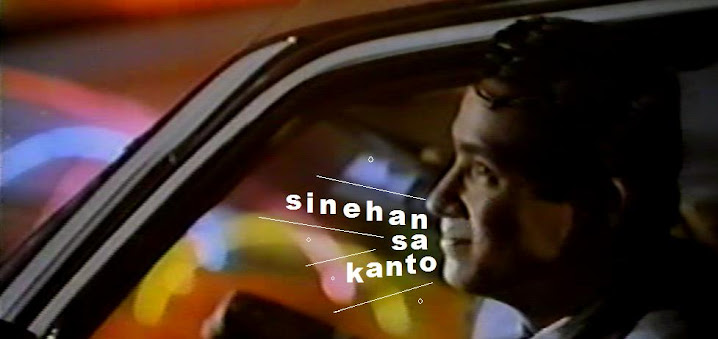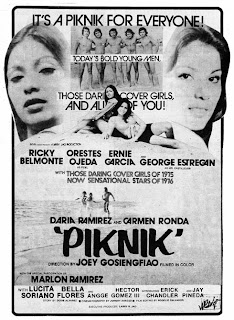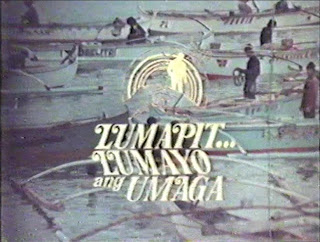 Philippine Cinema has always been very introspective. Not in a sense that the entertainment industry is as much a spectacle as its products, as seen in American Cinema, or even the deliberate self-examination of the art as seen in many European Cinematic movements. In the Philippines, self-reflection tends to be extremely personal, the film or entertainment industry as an extension of individual Filipinos' experiences, charting their hopes, dreams, and sad settling into the mundane life of being mere spectators. It's not just a spectacle, or an art, but life itself. Compare for example Singin in the Rain, which valorized Hollywood's artifice to Bernal's Pagdating sa Dulo, which charted the creation of a movie through the ups and downs of the bit players that create and are shaped by the movie. Or, a filmmaker's relationship with his craft in 8 ½ to the actors and filmmakers' relationship with their dreams in Babae sa Bubungang Lata. From Stardoom, to Kastilyong Buhangin, to Bomba Star, to Bilangin ang Bituin sa Langit, Filipino movies about movies never really focus on the movies, but on the lore, myth, and sad reality of the people that make them.
Philippine Cinema has always been very introspective. Not in a sense that the entertainment industry is as much a spectacle as its products, as seen in American Cinema, or even the deliberate self-examination of the art as seen in many European Cinematic movements. In the Philippines, self-reflection tends to be extremely personal, the film or entertainment industry as an extension of individual Filipinos' experiences, charting their hopes, dreams, and sad settling into the mundane life of being mere spectators. It's not just a spectacle, or an art, but life itself. Compare for example Singin in the Rain, which valorized Hollywood's artifice to Bernal's Pagdating sa Dulo, which charted the creation of a movie through the ups and downs of the bit players that create and are shaped by the movie. Or, a filmmaker's relationship with his craft in 8 ½ to the actors and filmmakers' relationship with their dreams in Babae sa Bubungang Lata. From Stardoom, to Kastilyong Buhangin, to Bomba Star, to Bilangin ang Bituin sa Langit, Filipino movies about movies never really focus on the movies, but on the lore, myth, and sad reality of the people that make them.Pepot Artista follows this tradition. Pepot is a young boy in the 70s, growing up during the limbo when the old Filipino cinema is about to die and the new, Third Golden Age of cinema is about to be born. Of course, it's already been born: Pagdating sa Dulo was made in 1970/71, many of Brocka’s early films have already been made, and Celso is already an active filmmaker. But it still hasn't asserted itself: Nora is still the female half of Guy and Pip and is yet to threaten to throw her baby under the bridge, and Boyet is still yet to condemn that small Nueva Ecija town. In a world of komiks featuring local movie stars, flash-bang shootouts with FPJ, and impersonators (that artform that Filipinos have mastered) at the local fair, Pepot is dazzled and sets about becoming a famous actor himself. The kid, of course can't act, can't sing, and has no redeeming features that could make him bankable. He could however dream. This world of celebrity deification however is built upon the crushed hopes and dreams of a nation, whose fortunes it saw dwindle and its future equally dim with the intensifying grip Marcos has on them. Nothing discourages Pepot to pursue his dream, other than the dire reality in which he finds himself. Yet, like Leolo, he dreams because he is.
Del Mundo does a very good job of capturing the film's milieu, especially knowing the kind of restrictions he must have had. (Forget the budget, how did he manage to get cell phones out of every single scene!? In a camera-crazy populace, how did he manage to keep regular passerbys from waving at his camera!?) His world isn't mired in the filth and sin of Brocka, Bernal, or O'Hara's Manila. Which makes sense, coming from a child's point of view where filthy squatters turn to impossible mazes and boring classes with physically abusive teachers (yeah, that teacher, it's Tado, a heterosexual drag queen of sorts who specializes in weirdly masculine women who would probably be clutching whips and wearing leather during their free time) turn to games that involve play on the teacher's favorite one liners. His children go to school, make money on the side selling gum and comics on the streets, and go to the movies or to the fair at night. They laugh, they play, they cry, and they dream. His adults as usual try their best and meet real world hardships with little luck, such as Pepot's father who is scammed by a recruiter promising a job in Saudi, or his mother who shamefully buys everyday goods on credit, or the his miserable teachers who must entertain their failed dreams through their favorite students.
But beyond their challenges is their consciousness of popular entertainment as an escape, as a way to make life more entertaining and more “real.” The mother especially likes to wail and weep like any on-screen suffering mother would do, and for the most part it's sincere with a bit of self-conscious irony added. The teachers, too, are over-dramatic and over-expressive, like any over-bearing teacher should be. In a sense, they dreamed, and they realize that they have failed, but that nevertheless does not suggest that they tire of entering the world that could have been. This to an extent is more palpable than those tired movie cliches where the mother would shout, “does acting put food on the table!?” Well, it doesn't, but in a culture so saturated by movies, it's impossible that anybody actually manages to escape the reality of celebrities, popular songs, popular komiks, and popular movies by being a miser. By suggesting a constant shifting but never ceasing relationship between movies and its spectators, del Mundo gives us probably the most accurate portrayal of just the kind of personal relationship Filipinos have with their movies.
It would be criminal of course not to mention del Mundo's almost Godardian slips of the fourth wall as his characters talk to the camera, meet older versions of the young stars that they adore, act out their fantasies, and point out the complicated identities of actors (imagine, an actor playing an actor playing himself acting, as Joel Torre's cab driver demonstrates). The actions are never left unadulterated. The characters once in a while make comments to the camera. And as a movie about dreams, del Mundo indulges some of the characters in having their dreams filmed: the Guy and Pip impersonators sing with Nora and Tirso's voices, the mother gets her own melodramatic background music, and the students act out their heroic characters in the school play. But unlike the special lights and fans in Singin in the Rain, del Mundo never films them in glamour. Instead, he indulges them during the height of their banal everydayness. Sure, it puts an emphasis on the broken dreams to come, the unfulfilled promises, and the disgusting normalcy of the everyday compared to the fabulous life of an entertainer, but not necessarily. Del Mundo does underline the reality of his characters, but instead of dwelling in their misery, he gives their reality decency by demonstrating the glory of their dreams dreamed in their context. Del Mundo points out that these characters do not dream of otherworldly experiences, only a better life and a life with a certain purpose.
It's quite disappointing that many of Del Mundo's filmic references wouldn't have worked if he didn't overdo them. References to Biyaya ng Lupa would not have made any sense if the film didn't rapidly cut back and forth between the reference and the referred. Tirso Cruz III literally had to put his face next to a younger version on an old komiks to make the connection click. Only Joel Torre's appearance really made sense without the heavy hand, but it's because he still works, and his face is still familiar. It didn't quite work because it deprived the viewer of the thrill of seeing something new but not really, but therein lies the complexity of Filipinos' relationship with their own cinema: we love it, it sticks in our minds, but how can a memory be memorialized by an amnesiac? The movie directed its audiences a little too forcefully, but tell me, who the hell remembers those wooden coin banks?
Despite the need for such obviousness excusing the presence of it, it does point out one thing: that despite the film's “passion” for Filipino cinema, the result is along the lines of Tarantino. You can tell that del Mundo is a fan of the local cinema, and he reflects the Filipino craze for their own movies, but he doesn't really go into trying to understand that craze. Like Tarantino, he goes nuts trying to recreate the scenes from movies he love, poking fun at some of them, even (lovingly, of course). But he stops there. He could have broken down the Nora's very politically charged image—something that O'Hara first recognized when he cast her for his Tatlong Taong Walang Diyos, and something that he almost realized when a Nora impersonator declared she too can be a superstar, with her “shimmering brown skin”—or the business of image saturation, with actors' faces appearing in notebook covers, komiks, cinema, banners, and as a result, in dreams, aspirations, and broken promises. Most especially, he doesn't really examine the fleeting nature of movies, especially Filipino movies, which are more ephemera rather than enduring works of art. Again, how can a memory be memorialized by an amnesiac? Del Mundo is content with a vague answer: we do, but we don't. He doesn't address that very painful love for the indigenous cinema, much like loving an older woman, of feeling intense passion but cognizant that love and beauty have already been claimed by time. We settle for their contemporary selves—although beautiful, only a meager reminder of what they were.
Peopot Artista suffers from the same problem that other valiant efforts of this contemporary Filipino independent movie scene suffer, which is good try but with the crappy means to make it good cinema. I've said it before and it needs to be said again, that digital images do not have the depth of chemically-produced images, and bodies in digital movies always look and feel like they are moving in a two-dimensional world. Now, with a little bit of effort this does not have to be the case, like the images in Pagdadalaga ni Maximo Oliveros, but del Mundo I believe does not have the chops of Aurelius to really make the means that he has work for him. His scenes are extremely flatly lit and composed, which really emphasizes the limited gradience of digital colors. His colors—in the clothes, the komiks, the small alleys—pop, but not in a good way. Garish and monochromatic, the electronic colors are sad but without the dignity of running make-up.
Peopot Artista is a respectable effort that displays one’s loves cut short by the lack of means to make it good. The camera and the story settles into a languid study of life, but that study is cut short by the frustrating plastic effects of video—which, like 8mm films, emphasizes the movie as a video, as a capture in time and nothing more. The movie wasn’t painted using light and shadow. Rather, it was a product of a point-and-shoot camera that brought no dignity to its characters. Pepot Artista offered us a glimpse of our cinematic selves, but like a deteriorating VHS copy of a really good movie, it’s just irritatingly not enough.





